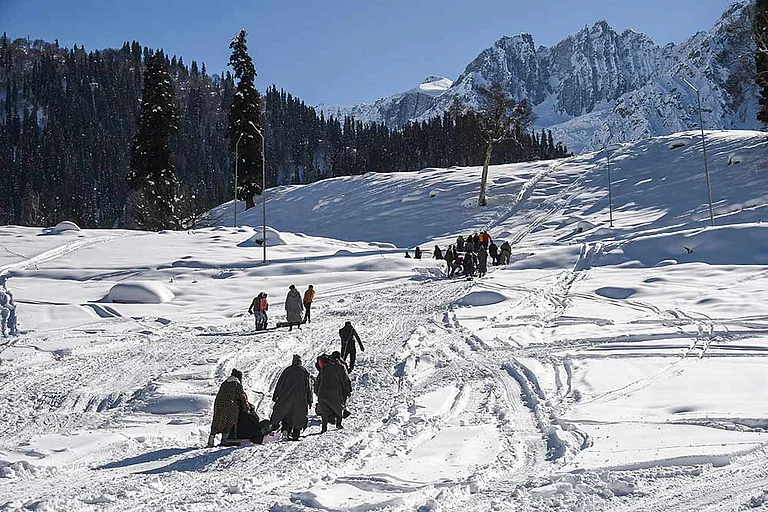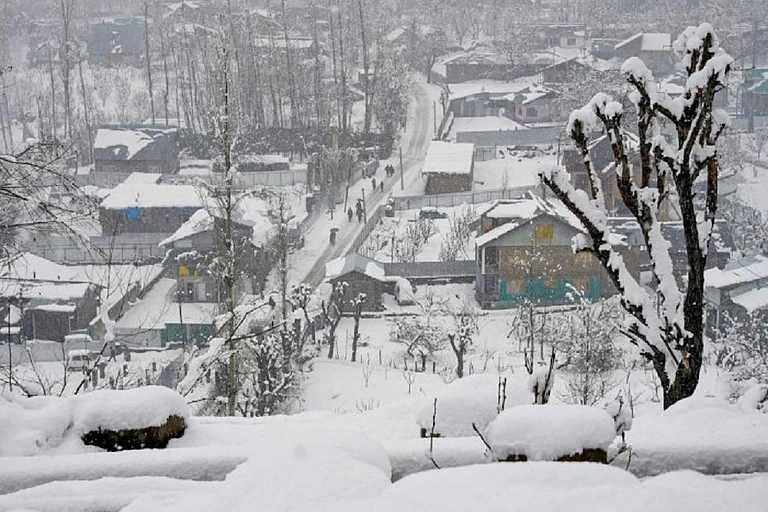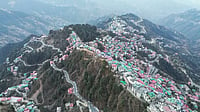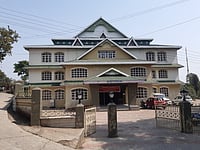The hills are experiencing an unprecedented weather pattern. An unusually warm winter, rain deficit and less snow are disturbing signs in traditional climate conditions essential for the fruit economy, especially the apple crop that is entirely dependent on favourable weather events and soil moisture.
Not only Himachal Pradesh’s high hills, but also many areas of Uttarakhand and the lower plains of the two mountain states in the north are facing the biggest onslaught of the extreme weather. This year’s winter has been particularly dry―rainfall deficit was 99.7 per cent in January 2024―breaking the 103-year-old record. It was 85 per cent in December 2023.
Admits Devinder Sharma, a food and climate change expert: “It’s only on the last day of January, the upper reaches of Himachal Pradesh, Kashmir, Ladakh and Uttarakhand received the season’s first snowfall—almost month and half late. A snowless winter at the time of a changing weather pattern raises concerns over what awaits the Himalayas in the future.”
Though February began on a good note―with moderate snowfall finally descending on the dry orchards and rains accompanying the sudden change―Sharma points out thelong term impacts of dry winter on fruit crops, agriculture production and reduced drinking water and hydro-power availability.
“Although a lot is known about how a snowless winter deprives the apple plantation of the chilling temperature requirements it needs in the winter months, and why apricots for instance have startedblooming early in winter,” he asserts.
Unusual weather patterns have brought our attention as well as that of policymakers on the environmental fallout,and how it impactsthe economy of the region.
The power production in the hydel projects has already crashed between 80 and 85 percent due to low water discharge in the rivers in January. The drinking water availability in major urban towns like Shimla has already been hit, and could fall drastically in the coming summers if the region doesn’t get sufficient snow.
The ideal months for snowfall, as the trend was in the 1970s and 1980s, were December-January. Old-timers in Shimla recall how they used to wave through 4-5 feet of snow which at higher hills used to act as snow-reservoirs (snow galleries), storing enough water, which also helped in soil recharge. But now a delayed snowfall having a high water content melts instantaneously, hours after its few short spells.
The failed rains in the lower hills have dealt a blow to the irrigation scheme. Perennial water sources—‘Kulhs’ and canals flowing from the foothills of the Dhauladhar range—were dry in January, besides the area witnessing usual frost.
Extreme weather conditions have started worrying climate change scientists as evidence shows that the worst affected to the ongoing changes in the weather pattern will be more severe in the Himalayan states. The broader impact of the altered weather cycle is not only affecting the quantity, but also the quality of apples produced in Himachal Pradesh. The apple industry alone is worth Rs 5,500 crore in the state.
In 2023, the state faced relentless rains resulting in landslides and flash floods resulting in the loss of 500 lives and economic losses to the tune of Rs 1,000 crore. The agriculture crops and orchards in the two key districts of Kullu and Mandi also bore the brunt of adverse conditions.
Unlike many countries, apple cultivation in the region is highly temperature-dependent, and warmer winters disrupt the natural cycle required for proper tree dormancy and subsequent fruit development. Any reduction in output affects the income, livelihoods and the overall economy of the region. Due to climate change, there has been a gradual shift of apple cultivation to higher altitudes as the growers are adapting to changing environmental conditions.
“This year’s winter doesn’t feel the same in the cold desert of Spiti. Except for the past few days, when it started snowing―almost two months late―the mountains were all dry and brown. Previously, the region used to be freezing under 5 to 8 feet of snow and temperature dipping to minus 12°C or 14°C,” says Tashi, a native of Kaza town.
Warmer winter and altered precipitation patterns may lead to changes in the growing season and crop duration. This can affect the timing of planting and harvesting, impacting the overall crop yield,” he adds.
In the apple growing areas, delayed snowfall and failed rains adversely affects the requirements of sufficient chilling hours for apple plants. These are very crucial for breaking dormancy in the apple trees. The reduction in chilling hours and the change in the timing of snowfall contribute to poorquality apple yields. The warmth resulting from climate change adversely affects the texture, taste, and the overall quality of the apples harvested.
In temperate and sub temperate regions, snow in winters serve the crops as white manure by supplying water slowly as per the infiltration rate of the soil and helps the plants to meet both their chilling and water requirement.
Temperate fruits like apple, almond, peach, plum, pear and cherry generally require a chilling temperature between 0°C and 7°C in varying amounts by different fruits to break dormancy and exhibit normal growth.
Early snowfall or rains in November, December and January months are considered good for meeting the chilling requirements.
Prakash Thakur, a progressive orchardist at Thanedar, says, “Poor snowfall or failed rains and unusually rising temperatures disrupt the natural flowering and bud break cycle of apple trees. Hopefully, things will change in the next few weeks as lastweek’s rains and snowfall have finally broken the dry spell. God seems to have answered our prayers and saved the crop.”
During the first five days of February, he says, the orchards received good snowfall, though it came after an unprecedented dry spell. The rains will prove very beneficial for all the fruits including plum, apricot, cherry and almonds, besides apples.
Studies done by the scientists at Dr Y S Parmar University of Horticulture & Forestry, Solan, reveal a decreased trend of snowfall at the rate of 82.7 mm/annum in the entire region of Himachal Pradesh, further emphasising the long-term impact of climate change on apple cultivation.
Barring Kullu, all 11 districts reported 100 per cent rain deficiency in January 2024. Kullu reported a precipitation shortfall of 90 per cent.The state had reported precipitation deficiency in December upto 85 percent.
Data from the India Meteorological Department (IMD) shows that Himachal Pradesh had grappled with a precipitation deficiency of 99 per cent. Earlier, the state had recorded similar weather conditions in 1966 with 99.6 per cent precipitation.
Former Vice-Chancellor of Dr Y S Parmar University of Horticulture and Forestry, Dr Vijay Singh, says: “Early snowing in November-January is best for apples as the orchards also need a warmer climate in March-April. Snowfall has happened late this season. But, since there is an overall pattern of climate change due to global warming, the orchardists must adapt to the changing scenarios even as the plants also change or adapt themselves according to the environment.”


























